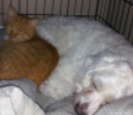All Care Guides
Litterbox Training Your Cat
-
Cats are usually easy to litterbox train because they are naturally clean and prefer to bury their waste. First, make sure that your cat knows where the litterbox is. Confine your cat to a small area or room with clean water, fresh food, and a clean litterbox until he or she is successfully using the litterbox and seems comfortable. Do not use a covered litterbox during the training period because it might complicate the process. If your cat urinates or defecates outside the litterbox, place the waste in the litterbox; the smell should help your cat find and use the litterbox in the future. If your cat isn’t using the litterbox after a day or two, do the following: After your cat eats, place him or her in the litterbox, and briefly scratch the litter with your finger. However, don’t force your cat to stay in the litterbox; you don’t want your cat to have a negative experience in the litterbox.
Lyme Disease Tests and Vaccine
-
Lyme disease is an infection caused by the Borrelia burgdorferi bacterium. Lyme disease is transmitted through the bite of an infected tick and can affect many species, including dogs and humans.
Read More Microchipping Your Pet
-
It is recommended that you identify your pet even if you don’t plan to let him or her go outside. Even “indoor” pets can get out by accident, and many lost pets are never returned to their owners because they have no identification. Collars and tags are popular, effective methods of identification, but they can come off. Microchips, which are implanted just under the pet’s skin, are one way to permanently identify pets.
Read More Neutering
-
Neutering, also known as castration, is a surgical procedure that involves removal of the testicles. It is a common surgical procedure performed on male dogs and cats to eliminate the ability to impregnate females. Neutering is also used to treat certain medical conditions, such as testicular cancer, anal tumors, and some forms of prostate disease.
Read More Nipping and Mouthing by Dogs
-
Nipping and mouthing are natural, usually nonaggressive behaviors that dogs use to communicate during play and normal interaction with other pets and people. However, most people don’t appreciate nipping and mouthing by dogs, and adult dogs can inadvertently cause injury while nipping and mouthing. Therefore, these behaviors should be discouraged starting in puppyhood.
Read More


































